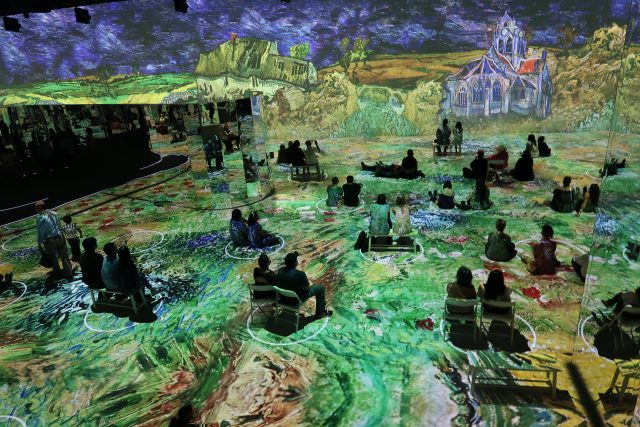
“Immersive Van Gogh” features three rooms of music and large-scale projections (photo by twi-ny/mdr)
IMMERSIVE VAN GOGH EXHIBIT NEW YORK
Pier 36, 299 South St.
Daily through September 6, $29.99-$99.99 (return engagement November 17 – January 2)
www.vangoghnyc.com
VAN GOGH: THE IMMERSIVE EXPERIENCE
Skylight on Vesey, 300 Vesey St.
Daily through September, $49.90
vangoghexpo.com/new-york
Discussing the success of a 1935–36 eponymously titled Vincent van Gogh exhibition at the Museum of Modern Art, a MoMA press release explained, “In the opinion of Alfred H. Barr, Jr., Director of the Museum, van Gogh’s popularity is just what the artist himself would most passionately have desired. ‘Again and again,’ said Mr. Barr, ‘van Gogh wrote of his desire to make pictures for laborers, peasants, miners, weavers, fishermen, postmen, seamen, and shopkeepers — in short, for the great aesthetically naive public. It is the central miracle of van Gogh’s artistic career that with such an evangelical desire for popularity he never for a single moment compromised with the popular taste of his time — which was then even more lazy, conventional, and unadventurous than it is now.’ . . . van Gogh’s work itself is the cause of his popularity — and the interest aroused in the tragic life of the artist due more to the appeal of his art than vice versa.”
Over the last several decades, van Gogh exhibitions at MoMA and the Met have deservedly been hugely popular, must-see events that draw long lines and come with a certain cache. When I posted on social media about my visit to one of two concurrent shows in New York City right now that re-create van Gogh’s work using immersive technology, I was surprised by how many of my friends, from across the socioeconomic and political spectrum, had already purchased tickets (primarily between $30 and $60) to at least one of the exhibits, well in advance of their openings. It is impossible to know what van Gogh or Barr would have thought of the idolizing demand; I can only tell you what I think about what turns out to be a pair of Instagram-friendly presentations that are not necessarily worth the price of admission. I suggest instead taking the money and going to a real museum, with real art, although you might not end up with such awesomely cool photos and videos to share online.
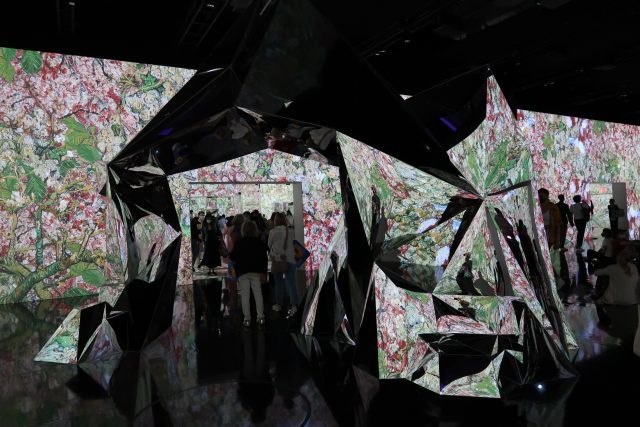
Mirrored sculptures offer Instagram-friendly opportunities at van Gogh show at Pier 36 (photo by twi-ny/mdr)
At Pier 36 on South St., “Immersive Van Gogh,” designed by creator Massimiliano Siccardi and New York City creative director David Korins, consists of three rooms, each larger than the previous, boasting more than half a million square feet of animated projections of the artist’s work. You enter through a narrow hallway lined with very basic facts about the painter’s life and career, along with brief audio narration. As you enter the first room, you are bombarded with a curiously random score consisting of familiar tunes as well as new music composed and curated by Luca Longobardi, echoing through the full venue, including Thom Yorke’s “Dawn Chorus,” Edith Piaf’s “Non, je ne regrette rien,” and Mussorgsky’s “Pictures at an Exhibition: The Great Gate of Kiev,” as dozens of van Gogh’s paintings come to life on four walls and the floor. Irises and sunflowers bloom, clouds swirl and stars dance, crows and cicadas soar, trees and wheat grow, and self-portraits emerge.
The songs are timed to each individual painting — Starry Night, The Potato Eaters, Bedroom at Arles, Café Terrace at Night — evoking the feeling of watching fireworks with the radio simulcast; one blast ends, and you wait with anticipation for the next flurry. It’s hunky-dory and all, silly fun, but it’s primarily a grand gimmick. Each room has mirrored sculptures that are not exactly organic to van Gogh in any way, instead merely offering the opportunity to take swell pictures of the works distorted in the reflections, along with selfies of you and your friends. Good luck trying to take a picture or video without someone else taking a picture or video in yours.
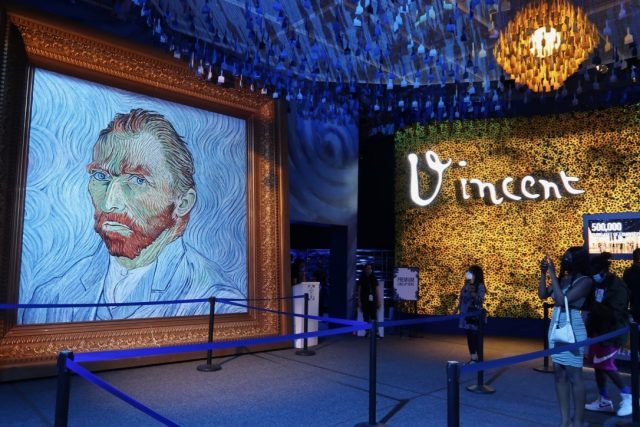
Lobby at Pier 36 installation includes oversized reproduction of van Gogh self-portrait (photo by twi-ny/mdr)
The third and largest room features an observation platform and benches to sit on and take it all in; putting away your camera and relaxing for a while, letting it flow over you, is not unpleasant, but so much of the animation is arbitrary and frivolous that it becomes tiresome. In the lobby and enormous gift shop, there is also a ceiling constructed of nearly eight thousand paintbrushes re-creating Starry Night, a Pocket Gallery where paint splotches explode off canvases and become famous van Gogh paintings using AR, an interactive sculpture in which visitors can ask a question and get a letter from Vincent, and a walk-in circular installation of ten booths that uses color, light, and sound to deliver a “chromesthesia experience” inspired by the possibility that van Gogh had a form of synesthesia, allowing him to hear color and see sound. Oh, I almost left out the fashion show in the exit hallway, a seeming afterthought in which mannequins are adorned with clothing inspired by van Gogh’s imagery. Or something like that. There are also jokes on signs using the pronunciation “van go,” which would confuse Diane Keaton’s character in Woody Allen’s Manhattan, who pronounces the artist’s name as “van gokh.”
Meanwhile, on the third floor space known as Skylight on Vesey, near Brookfield Place, the competing “Van Gogh: The Immersive Experience” offers a somewhat different trip into the work of the Dutch master, with a greater appreciation and understanding of Vincent as an artist, although not the kind of deep dive you’d get in a museum or gallery. You first make your way through several rooms that detail the influence Japanese prints had on him, his friendship with onetime roommate Paul Gauguin, his vase paintings (projected in 3D), his relationship with his brother, Theo, and his stay at the Saint-Paul de Mausole asylum in Saint-Rémy, complete with a nifty (but necessary?) re-creation of his bedroom at Arles. Digital reproductions of seminal works are hung on the walls (and are available in the gift shop). Quotes abound, both in the labels and on the soundtrack, narrated by an unnamed man who sounds like Jeremy Irons: “The way to know life is to love many things,” “I put my heart and my soul into the work and have lost my mind in the process,” “I dream of painting and then I paint my dream.”
In the central two-story, twenty-thousand-square-foot room, comfy beach chairs with Starry Night on them allow you to sit and watch a thirty-five-minute massive projection display on four walls and the floor as paintings come to life against architectural backgrounds. Rows of Van Gogh’s self-portraits, landscapes, flowers, and other works appear and disappear, sometimes with animation that makes it look like the canvas itself falls to the ground, revealing new works underneath. As opposed to the Pier 36 show, the one on Vesey St. concentrates more on van Gogh’s actual paintings; the works are usually seen within their frames, not busting dramatically out of nowhere, although a few do.
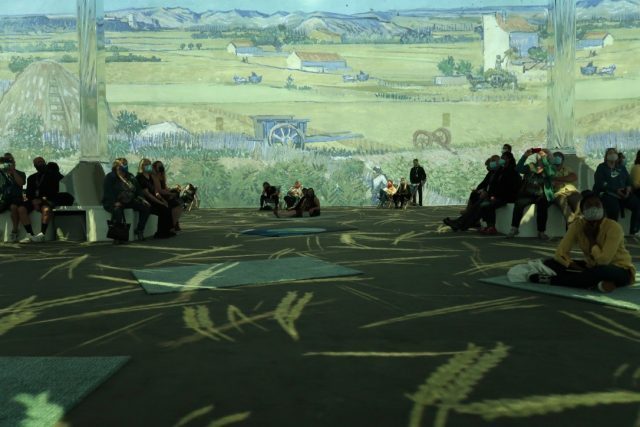
Skylight on Vesey van Gogh show has different perspectives that Pier 36 presentation (photo by twi-ny/mdr)
The bony figure in Skull of a Skeleton with Burning Cigarette takes a drag off his butt, smoke from a train envelops the space, vehicles move in Landscape with Carriage and Train and farm scenes, pages flip in Still Life with Bible, and a windmill turns in Le Moulin de la Galette, to the sounds of gentle classical music.
A series of self-portraits leads to an interactive workshop where you can draw your own van Gogh, followed by a virtual reality room where you are taken on a colorful 360-degree VR adventure through eight of van Gogh’s most important paintings, displayed in frames as you meander through nature and toward the sea in Arles, as if you are seeing the world as van Gogh saw it, and then painted it. Finally, the gift shop is tiny, which is a relief after the grandiosity of the competing exhibit’s extensive merch.
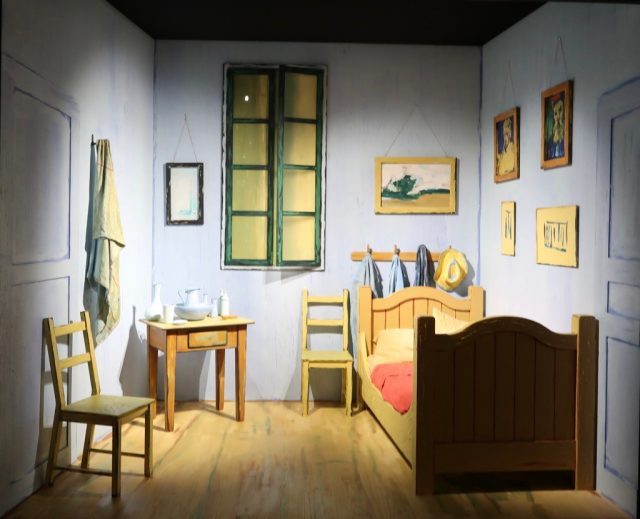
Vesey St. van Gogh show includes 3D reproduction of van Gogh’s Bedroom in Arles (photo by twi-ny/mdr)
“Success is sometimes the outcome of a whole string of failures,” van Gogh said. While the artist did not make much money from his art during his lifetime — the only recorded sale was of The Red Vineyard at Arles — his 1890 Portrait of Dr. Gachet sold for $163.4 million a century later. Now people around the world — these immersive experiences are being held in more than fifteen US cities and half a dozen countries — are paying upwards of $99 for VIP access to watch digital manipulations of his work that will look great on social media, but the experience is fleeting. Better to spend your money on immersing yourself in the real thing at the Met or MoMA, losing yourself in actual van Gogh canvases that will take you to another place, the crows and cicadas, irises and sunflowers, portraits and self-portraits, and wheatfields and starry nights invigorating your mind and penetrating into your heart and soul.